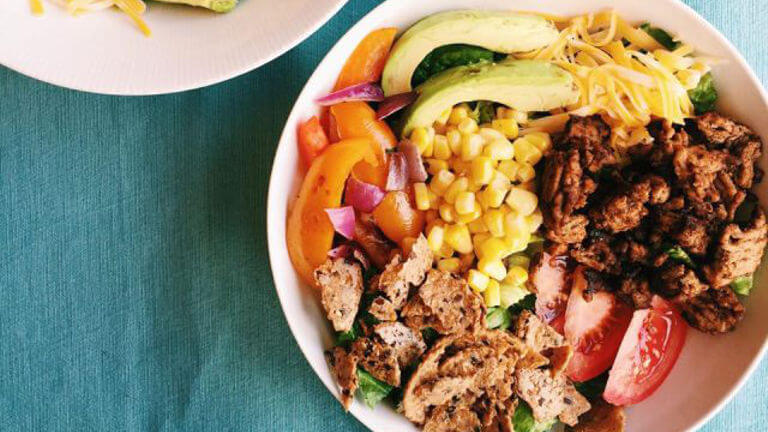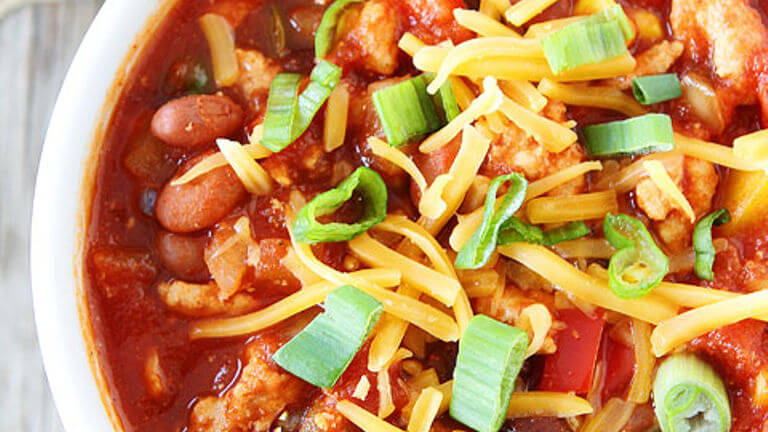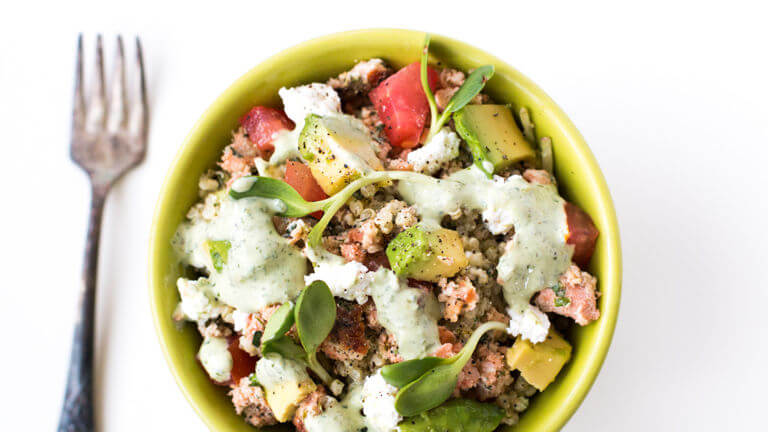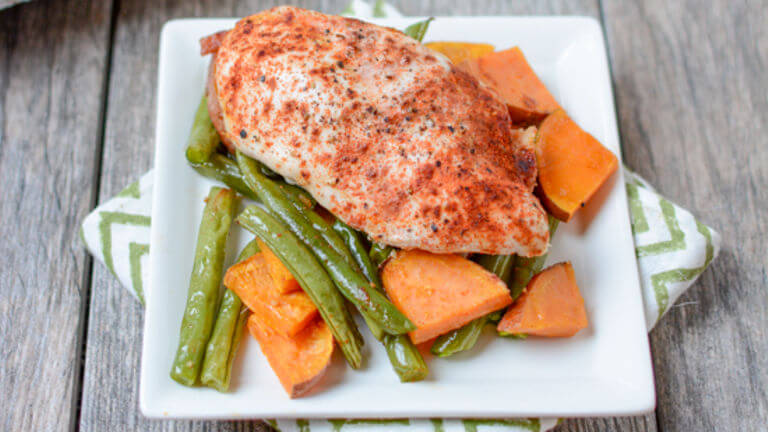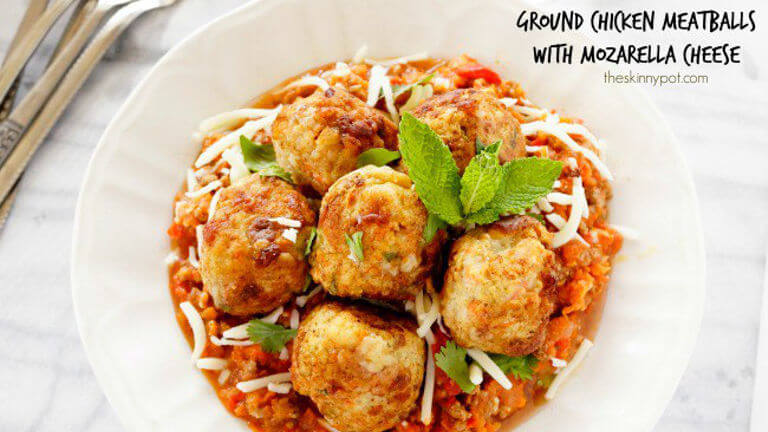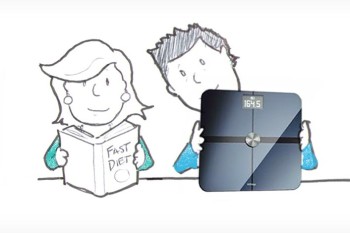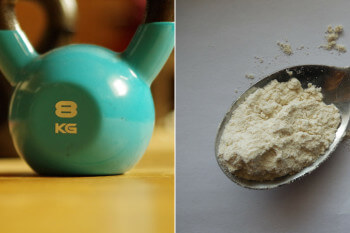If you missed Dr Michael Mosley’s original BBC documentary, “Eat, Fast & Live Longer” which sparked the 5:2 intermittent fasting phenomenon and brought intermittent fasting in general into the mainstream, here it is in full, via DailyMotion.
5 things that surprised people when they started intermittent fasting
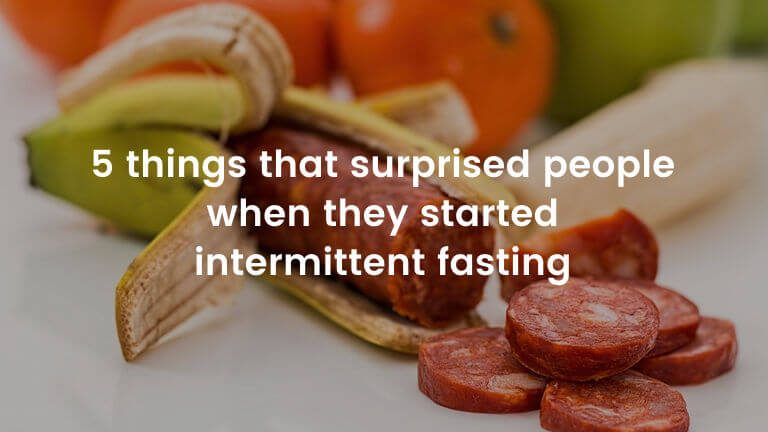
Intermittent fasting can sound quite daunting when we live in a society where food is almost always on hand and snacking throughout the day has become the norm. The idea of going without food for longer than usual and experiencing genuine hunger is a very real fear among new fasters – but one that we are pleased to say is short lived!
We asked the FastDay community what things surprised them the most when they began intermittent fasting – we hope their answers will reassure you…
1. Fasting gets easier
“I’ve tried every diet, and struggled with all of them. I wouldn’t call fasting easy, but I was surprised that it wasn’t as hard as it sounded!”
“I did find it easy!”
“5:2 was a diet I could follow without much difficulty… When I read about 5:2, I thought this was something I could do and I did.”
“I remember my first fast day well. I was surprised that it was so difficult. I thought I was going to die! Now fasting has become very easy. I am so glad I managed that first day.”
“Easy to fast until 1 p.m. With a cup of black coffee in the early morning, of course!”
“What surprised me was that it was relatively easy to fast”
2. Fasting teaches you not to fear hunger
“I think what surprised me was how easy it was to deal with hunger. It was something I had previously avoided, because I always felt like I would go out of my head, but that feeling passes pretty quickly. Have a drink of water, get busy with something, and it goes just like that.”
“What surprised me most when I started fasting? That I had no idea what it was like to actually be physically hungry. I hadn’t allowed myself to get actually physically hungry — Sure, I was often hungry for other reasons (boredom, emotional reasons, habit). But I ate so often that I had no idea what actual physical hunger was.
And I had no idea that it’s okay to be hungry, that I could go five hours without eating and wouldn’t pass out, and that when you’re actually hungry, even the healthiest food tastes great. Now I say “if I’m not hungry enough to eat an apple or carrots, I’m not actually hungry.”
“I didn’t feel hungry the day after a fast day.”
“That it is possible to work without eating the whole day. And mayby [sic] even More that next morning you are nottaa [sic] very hungry.”
“What surprised me was that… hunger was nothing to be afraid of”
3. Fasting works!
“I was surprised at how well it worked. I had had success with diets in the past, but not so much around the time I tried 5:2 (or 4:3 in my case). All my old tricks stopped working. So it was a pleasant surprise that I had a fairly steady downward trajectory.”
“The weight came off consistently and at a steady pace, which had never happened before.”
“I did so [follow 5:2] until I had lost more weight than I would have thought possible.”
4. Fasting helps you take control
“I could go out on a fast day and watch my husband eating cake etc and I was quite hapy to sit there virtuously with a mint tea without feeling envy because I knew I was finally in control.”
“after a while, I found that I didn’t get very hungry on non-fast days, so I was able to radically alter my way of eating.”
5. Group support can help
“The other really surprising thing is I’m not usually a support group type of person but having the Fast Day site and page available have really kept me going. Thanks!”
5 favourite lunch ideas from long-term 5:2 fasters
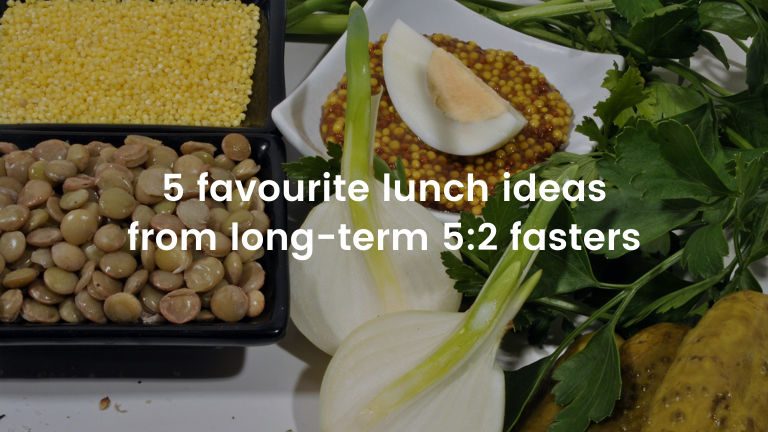
We asked the FastDay community what their favourite fast day lunches are – the answers may surprise you!
1. No lunch!
The majority of fasters said that they prefer not to have lunch on a fast day – or breakfast for that matter – saving all their calories for a good sized dinner and having a longer fasting period totally free of food. Many intermittent fasters find that as soon as they eat on a fast day, they feel hungry for the rest of the day – we like to call it ‘the hunger switch’, and a lot of fasters find it best not to flip this switch until absolutely necessary.
2. Yogurt and berries
Various fasters enjoy a sweet lunchtime treat with low fat yogurt to save on calories and a good helping of delicious seasonal berries.
3. Lettuce & deli meat wraps
Why waste calories on the carbs in a tortilla wrap when you can cut out the middle man and wrap your fillings in a big lettuce leaf? Some sliced ham or turkey with extra salad veg and a light dressing or hummus make a great filling for a low calorie lunch.
4. Egg & Salad
You can’t go wrong with eggs on a fast day (unless you’re allergic!) – packed full of nutrients and filling protein, a boiled egg on the side of a large, lightly-dressed green salad this fast day lunch is quick and easy. Rustle it up from whatever green salad ingredients you have in the fridge, throw in some tomatoes or peppers for some extra colour if you have them.
5. Quorn sausages with lentil salad
This was a new one on me so I just had to include it! I’d never heard of lentil salad and when I asked what was in it, it sounded delicious: lentils, bulgar wheat, cucumber, yellow pepper, red onion and mint leaves, dressed with lemon juice and olive oil.
For more fast day meal ideas, check out our recipes section or get some 100-150 calorie lunch ideas at the forum.
What’s your favourite lunch on a fast day? Let us know in the comments!
Is is true the 5:2 diet now allows 800 calories on a fast day?
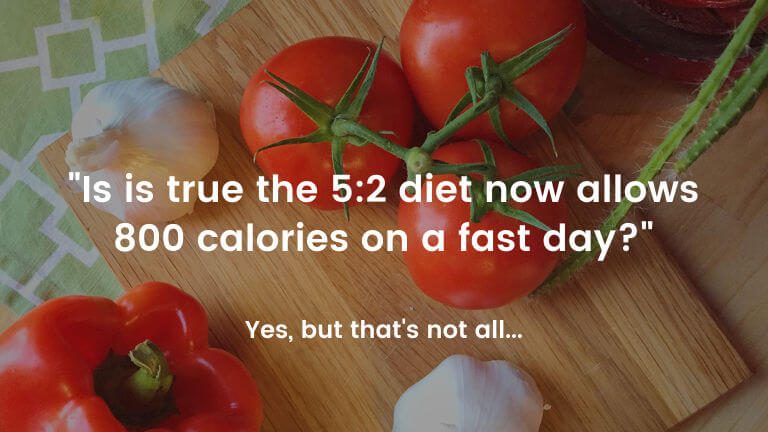
In recent months it has been reported that Dr Michael Mosley, author of the original The Fast Diet book, has ‘relaxed the rules of 5:2’ by increasing the fast day calorie allowance to 800 calories for men and women alike – that’s an extra 200 calories for men and a whopping 300 calories for women.
Fasting on 800 calories is really nothing new to the world of intermittent fasting, as ADF (alternate day fasting) has been using this figure for years and indeed some following a 4:3 fasting regime (3 fasting days a week) allow themselves this slightly higher calorie limit too.
While we agree that 800 calories may be easier for those who struggle with the original 5:2 diet calorie restrictions and that any calorie deficit can only be a good thing when trying to lose weight, many reports about this so-called change to the plan are incomplete and slightly misleading.
Dr Mosley is reported to have said:
“You don’t need to stick to 600 calories. Cutting down to 800 calories a day seems to be almost as effective and for some people much more ‘doable’.”
“It’s low calorie, without being superlow-calorie. And if you want to have lunch, you can slip those extra 200 calories in there.”
However, what often missed out in these reports is that Dr Mosley also says that if having 800 calories on your fast days, you should follow a low-carb/Mediterranean style diet for the other 5 days for it to be as effective in terms of weight loss. While Mediterranean style eating may be normal for some, for others it will feel more like a full time diet, with daily restrictions and less freedom than allowed by the original style 5:2. Not that normal 5:2 should be used an an excuse to binge or make poor food choices on every non-fast day, but certainly its flexibility and the part-time nature of the plan is key to what has made it so sustainable in the long term. We all know long term compliance is a big issue when it comes to a diet (or, ‘way of eating’ as we prefer to call 5:2, as ‘diet’ can imply a fad or short term fix) and the best plan for anyone is one that they can stick to.
Certainly it’s good advice to reduce the amount of processed and sugary foods we eat, but doing so can involve more willpower and may make this ‘new style 5:2’ on 800 calories somewhat more difficult to stick to than the original form. Another point to note is that with a lesser calorie deficit, weight loss results may be slower (if not combined with low-carb/Med eating on the other days) and this can be disheartening for a new starter.
Keep it simple for starters, that really is the joy of 5:2.
Our advice? Stick to pure 5:2 and before long you’re likely to find yourself making healthier choices on the other 5 days anyway. When you reach your goal weight perhaps then could be a time to consider switching to 800 calories on your fast days for maintenance purposes.
If you’re already a low-carber however and looking to shake things up a bit, perhaps fasting twice a week on 800 calories would be a helpful new addition to your weight loss arsenal!
Have you tried the ‘new style 5:2 diet’? Share your results with us in the comments!
5 high protein fast day dinners under 500 calories
Credit: A Teaspoon of Bliss
Taco Salad Bowls
500 calories per serving
A colourful bowl full of Mexican spiced goodness.
Credit: Two Peas & Their Pod
Slow Cooker Turkey Chili
498 calories per serving
A hearty slow-cooker recipe which makes plenty of portions.
Credit: Meg is Well
Salmon Quinoa Bowl
400 calories per serving
Filling, fresh and ready in a flash!
Credit: The Lean Green Bean
One Pan Roasted Chicken and Vegetables
335 calories per serving
A great one-pan wonder for a weeknight dinner which makes enough for the whole family.
Credit: The Skinny Pot
Ground Chicken Breast Meatballs with Mozzarella Cheese
325 calories per serving
A low calorie meatball packed full of flavour – and with enough calories to spare for serving with a tomato sauce and zoodles!
7 Great Tools Every Faster Needs!

1. Bathroom Scales
Don’t dread stepping on them, even if they do sometimes lie*
Most people who fast are doing so at least in part for weight loss (and of course health benefits and weight loss go hand in hand!), so to track your progress a pair of simple bathroom scales are an essential which needn’t break the bank. It’s even possible to measure your body fat % on some inexpensive models available on the high street. As with many things in life you can find a scale to suit your budget – be it a basic model or a modern set of wifi scales complete with automated tracking and a weather forecast!
Cost: From around £10.00
* Why do the scales sometimes lie? Read this!

2. Measuring Tape
A more accurate method than counting belt notches!
You’ll notice your shape changing as you lose weight and it’s a great motivator and measure of your success to keep track of those vital statistics with a handy measuring tape, available from all good sewing shops for little more than a song*. Just be sure not to pull the tape too tight when you measure if you want an accurate reading, and try to measure around the same spot each time. For some tips on where and how to measure, click here.
Cost: Around £1.00 at most
* Please note that singing to the cashier may not be considered a valid form of payment for your purchase!

3. Kitchen Scales
Weigh your food when preparing it to get those calories just right!
When it comes to calorie counting for your fast days, every gram really counts so accuracy is important if you want to stay within your calories. A pair of digital kitchen scales will aid in your food preparation as well as allowing you to divide out equal portions when you batch cook. Some of the fancier models will even give you nutritional information about the food you’re weighing, which will please those of us who thrive on this kind of detail. Now go and find some yummy recipes on the FastDay Food site!
Cost: From around £10.00

4. Oil Spray Pump
Fat, regardless of what you may have been led to believe, is not the enemy!
Natural fats are good for us and our body is able to process them more easily than the modern day additive-filled overly processed alternatives. Why use a low calorie can of oil spray which may contain as little as 50% natural oils when you can use the real thing? Not only is this better for you but it’s also better for the environment as you’ll be reusing your sprayer rather than throwing away the empty spray can each time!
Cost: From around £10.00

5. A Smaller Plate
It’s all in the mind!
If you’re splitting up your fast day calories, a simple psychological aid in the early days is to use a smaller plate for your meals as it makes the meal look bigger. You may even find yourself using it on feed days as your appetite decreases.
Cost: From as little as £1.00 – you may even already have a side plate you can use!

6. Recipe Collection
Planning your eating is the key to fasting success!
Variety is the spice of life and a good collection of recipes for your fast days will help keep boredom at bay and make this way of eating sustainable for you. There are lots of great recipe books available specifically for intermittent fasters and most are very reasonably priced. You can also find lots of fast day friendly recipes online with a quick Google search, or simpler still why not pop along to the FastDay Food area and search the collection of recipes we’ve compiled for you from around the web?
Cost: Around £5 or less for most fasting recipe books, or our FastDay Food collection is free!

7. Fasting friends
We’re not actually calling your friends tools!
We’ve probably all tried to go it alone before but if we’ve learned one thing from the FastDay Forum it’s hat having friends who support and understand what you’re doing is really beneficial. Fasting is relatively new in the world of weight loss and there are sadly still a lot of nay-sayers to contend with. Joining up at the forum means you can meet lots of lovely people who believe in fasting – many who have achieved great success – to inspire, motivate, offer support and answer your questions. Best of all, it’s free!
Cost: The forum is free but the friends are simply priceless!
12 week expert-coached Fasting Program
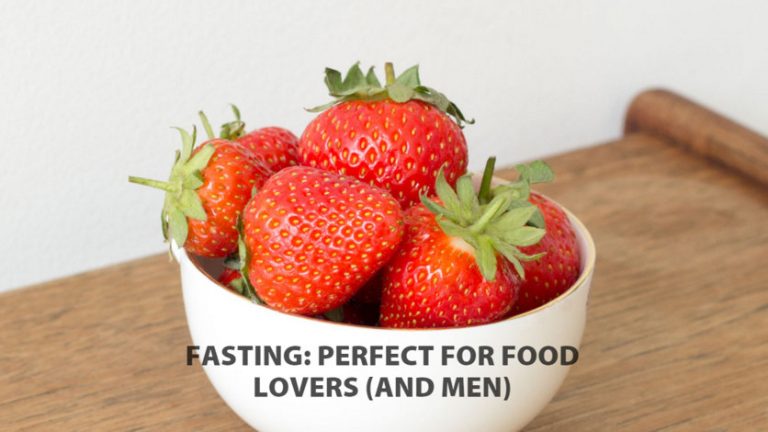
Intermittent fasting is often called 5:2 fasting. It has become very popular in the past few years.
You drastically reduce your food intake for 2 days each week (500 calories for women; 600 for men). On the other 5 days each week you eat normally.
Many people use fasting to lose weight. It is also a great long term way of eating. It is easy to do, controls your weight, and shows promising health benefits for conditions such as diabetes, heart disease, cancer and Alzheimer’s.
We have designed many aspects of our 12 week fasting program with Ways of Eating to make the best of the 8 factors that make people more likely to succeed.
The Fasting Program guides you through the first steps with 5:2 intermittent fasting, getting your journey to a healthier, slimmer body – and a more relaxed attitude to food – off to a flying start.
“Excellent introduction to fasting. Plenty of information, prompt answers to a variety of questions. Great support from a knowledgeable leader and group. Would recommend!” Wendy, Scotland
About this program
Lead by an experienced faster, who will guide you through the first steps, the Fasting Program is a comprehensive introduction to intermittent fasting. You’ll have two ‘fast days’ a week during which you will have a restricted calorie allowance (500-600 calories). The other days of the week you eat normally.
The program includes:
- 12 weeks of personal expert coaching at a fraction of the cost of face-to-face nutritional consultations.
- Learn about food and nutrition to make healthier choices.
- Easily log your food & progress to receive advice and feedback from your coach.
- Form new habits and discover your own way of eating for life.
- Chat groups to connect with your fellow fasters.
What you’ll get out of this program
By the end of the 12 weeks of the Fast Start program you’ll be comfortable with fasting and be able to plan your meals and your fast days to fit your own lifestyle; you’ll have experimented with different ways of fasting and be ready to go it alone. You will have learned a lot about yourself and the way your body works and will almost certainly have seen changes in your weight and your attitude to food and hunger. We also hope you will have ditched guilt about food forever, and found a way of eating well for life.
Kate’s 5:2 Diet Success & Maintenance
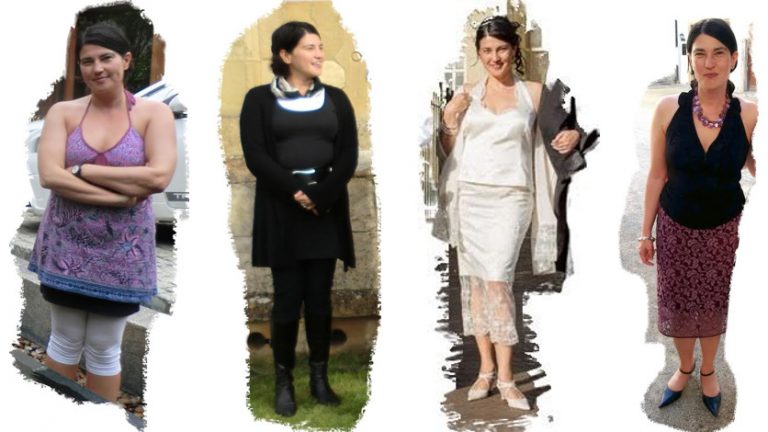
My dear fellow FastDay-followers,
My apologies for being mostly a silent reader of the forum – the main reason being “being very busy at work”…. But, I owe you an update – and be it only to say thank you for the motivation and great insights I am still getting here!
I have been maintaining now for a year (I reached my goal weight of 62 kg in August 2014, just in time for my wedding – THE trigger for starting 5:2 in the first place!) and I am now, one year in, between 62 and 64kg, depending on form of the day. But I also do not care so much about the exact numbers, I measure myself mostly by dress size, and I am still a size 10. When I feel my jeans getting a bit tight I will make an effort and put in an additional fast day or eating window day, or also 2 (after a holiday) , and then usually I am back on track.
The biggest difference for me is that 5:2 has liberated me from the feeling of being a perpetual victim of dieting! Before 5:2, I would either diet (=be miserable), or not diet but then already know that I would regret it later, thus “be miserable in advance”. I couldn’t remember when was the last time that I had really fully enjoyed a meal, a party, a nice romantic dinner without feeling guilty – or miserable.
All the things I wrote in my first post, last year, about being delighted with this WOE are still true, thus I won’t repeat them here fully.
Instead, let me rather share my experiences with maintaining the weight.
First I tried to maintain with a strict 6:1, but that did not work. The weight would not stay off. So I knew I had to do something more drastic, like going back to 5:2, and because I had read so much about Cortisol (thanks to @carorees for making me aware!), I knew I had to control it. I really do love my job – but it often has pikes of crisis situations, where even if my brain knows that it is “business as usual”, my body still produces the adrenalin and here we join the jolly circle of “cortisol increase>stop-fat-burning-and-start-piling-it-up-at-the-tummy”… I also know I am very sensitive to carbohydrate, I need to keep an eye on it. I don’t make an effort to eat low-carb all the time, but on my fasting days – which I try to do consecutively now – I eat no carbohydrates (except for those included in vegetables or milk) and nothing that would trigger insulin. So I have a very boring Mondays and Tuesdays, with lots of tea and some coffee, but no food during the day (only dinner), and no insulin-triggers.
After that, I am “reset” – and then eat “whatever I want” for the rest of the week – but of course you all know that what you want has changed as well: less quantities of food, less sugar. I don’t observe TDEE consciously – mostly because I love the simplicity of 5:2 and cannot handle all the data and numbers all the time. I want to keep it simple for me, and the routine I found now seems to allow me to do it.
If I feel that my 2 days were not enough – or I gave up on the evening of the 2nd day, I will try and have some more “eating window”-days during the week, depending on social obligations. I just love the flexibility which I have with 5:2, or intermittent fasting, since my “mix-and-match” isn’t really strict 5:2 anymore.
In summary: I lost 8 kgs with 5:2, over a year (2 days of 500 kcal and 5 days of TDEE-watching), and now maintain with a mix of 5:2 (2 days of 500kcal low carb, and 5 days “eat whatever”) and eating windows on some of the other days. Sometimes I struggle, but so far have always managed to get back on track.
Greetings and much fasting success to you all.
Going away? Read our top tips for fasting on holiday!

We touched on this issue in the last FastDay Buzz article about fasting as a parent, but with the summer holidays drawing ever closer it seems a good time to delve a little deeper!
So, you’re going on holiday and you’re an intermittent faster… what do you do?
How should I decide what to do?
This very much depends on how long you’ve been fasting and whether you have reached maintenance or not. If you’re a long term faster and you’ve been maintaining for a while, you probably don’t even need to read this article – you’ve got it nailed and you know what works best for you when it comes to keeping the weight off – well done!
If you’re a new faster, these first couple of months for you are really the most important when it comes to changing your habits for the long term and letting your body adjust – I would strongly suggest you continue your normal fasting routine while on holiday in order to help your new healthy way of eating become normality for you and to maintain the new sense of control over food that you are likely now feeling.
What if you’re somewhere in between? You’re a long-term faster who hasn’t yet reached goal or perhaps have just reached maintenance? Now it depends a little on the length of the holiday. By now you’ve quite possibly had a week here and there where you’ve had to miss a fast, or even a week off – so you know how to handle this and for a shorter holiday if you know you can be relatively sensible for a week then use your best judgement! For a longer holiday – well, I’d be inclined to have more of a plan in place myself. It’s very easy to become complacent, trusting that the scales will go down each week, feeling we know what we’re doing so well that we let things slip a bit. This can be a slippery slope indeed, so do try to decide ahead of time what you aim to do about your eating habits on holiday.
To lose or not to gain, that is the question!
Many of us can feel disheartened when we step on those scales and the numbers stay the same, or worse still go up a little. If you haven’t already read about Why the scales don’t tell the truth I highly recommend it – it’s our most popular article for a good reason. It’s so important to remember that a maintain or seeing minor fluctuations on the scale is so much better than seeing them go ever upwards week upon week. A maintain (give or take a pound or so) isn’t something to get upset about – it’s a victory in the battle against weight gain!
With this in mind it’s important to set yourself a realistic outcome for your holiday. Yes, most of us are trying to lose weight – but is it realistically achievable for you given the type of holiday you are going on and how long you’re going to be away? If you stick with the plan and don’t over indulge, then yes it is possible for you to come out of your holiday with the scales and tape measure showing you the same sort of numbers they would have if you’d stayed at home. But, to do this will take strength and self control.
One of the reasons many of us love this way of eating is because we like food. We enjoy being able to eat as normal on our non fasting days and we learn that it’s not about complying to strict rules 100% of the time, but about the bigger picture – blips and all! We can’t eat like pigs on our non fast days all the time and expect to still lose weight – however, we know it’s okay to indulge from time to time, or to have those treats because it’s all part of that bigger picture and an overall downward trend.
So, imagine this week, fortnight or however long your holiday is, in the overall bigger picture that is your whole life. Would a week off really matter in the long term if you know you’re going to do this forever? Would a maintain for the duration of the holiday, or even a couple of pounds to re-lose be so terrible in the grand scheme of things? Probably not.
Consider how the outcomes would make you feel then take hold of those feelings and put them in check. It’s OK if you come back the same weight rather than losing and it’s not terrible to put on just a little if you know you’re can shift it again. Sometimes these small ‘gains’ can be a result of the scales and their lying ways, but don’t let this lull you into a false sense of security – it could actually be real weight gain, so try not to let it get out of hand. We all know that over-eat->gain & guilt->emotional over-eat cycle too well and need to break it.
An important thing to bear in mind is your general rate of loss and how long it will take to lose those holiday lbs – the average rate is about a pound per week. Ask yourself now, are you really happy to spend 2 months undoing the weight gain from that 2 week all inclusive holiday of indulgence? If the answer is yes, then go and enjoy yourself! If not, do read on…
What’s the plan, Stan?
Okay, so you know you need to do something to prevent the weight gain while you’re away but you’re not sure what might suit you best? If you missed it earlier, those who are new to fasting are best trying to keep to their new 5:2 habit if it is going to become their normal way of life.
If you need a different plan for your eating on holiday, here are some ideas to consider…
16:8 ‘feeding window’ fasting
If your holiday destination doesn’t include breakfasts this could be the option for you! The 16:8 method of fasting and other ‘feeding window’ methods like Fast-5 give you the health benefits of a fasting period while also helping you – in theory at least – to reduce your calorie intake each day.
It’s really simple – pick yourself an 8 hour period (or 5 hours if you’re trying Fast-5) in which you will allow yourself to eat each day. Midday to 8pm or 1pm to 9pm are popular, allowing you to have a lunch and dinner but effectively skipping breakfast. You get the benefit of a 16 hour (or 19 for Fast-5) fast each day while eating as normal during your feeding window. It’s not totally foolproof as of course it is possible to over-eat during the window – but with a bit of mindfulness this is a great way to maintain on holiday and can even be effective for weight loss if followed on a daily* basis.
(*again, as we know, it’s the bigger picture which matters – if you eat outside of your feeding window no and then it is not ruin everything! One day on its own does not make, or break, a way of eating for life!)
Calorie balancing
If you haven’t already watched The Men Who Made Us Fat, do try to find the time to – it’s a real eye opener about the food industry and our eating habits. The key thing I took away from this documentary series is that many of us have lost the ability to (or the feeling that we need to) balance our calorie intake. As always, we should look to the bigger picture – our daily calorie needs can be scaled up to weekly needs and balanced over that period. If you over-eat one day, you can balance it the next. This seems to be the normal behaviour for many naturally slim people – after over indulging they don’t feel so hungry so they eat less – thereby balancing out their calorie intake in the longer term. This is a much healthier way to manage your food than falling into the over-eat->gain & guilt->emotional over-eating cycle!
So, while you’re on holiday if you find yourself overindulging, try to balance it out. Big lunch? Have a small dinner and cut back on the wine. Big dinner? Skip breakfast (contrary to popular belief it’s not really ‘the most important meal of the day’).
A different kind of 5:2
Have you seen any of those articles about “5:2ing your life”? It’s not all just about fasting 5:2 style, it’s about taking a couple of days a week to make healthy changes in your life. If you can’t fast 2 days a week while on holiday, maybe you can 5:2 your holiday in some other way. What eating habits could you commit to changing for 2 days of each week on your holiday? Maybe you could…
- Go without alcohol
- Skip breakfast
- Cut out the snacks
- Have smaller portions
- Go low-carb (if you’ve paid for a fancy dinner, make the most of the expensive protein and veggies and cut back on the side of carbs – you could ask for extra veg instead!)
After all, it’s only 2 days a week! Of course, if you feel able to do any of these for more days of your holiday it can hardly be a bad thing.
Feels just like starting over…
New habits take time to form but bad habits can be hard to break and they return far too easily!
If you’ve ever had a week or more off fasting then I probably don’t need to tell you this – when you return to fasting after some time off, it can be just like starting over. No, I don’t mean losing 5lbs in the first week (although you may get lucky and find that you do shift a load of water weight like that)… I mean the less pleasant side effects of fasting. Most of these will have subsided for you within a few weeks of starting, but be prepared to experience headaches, light-headedness, grumpiness and difficulty sleeping when you ‘start again’. It really can be just like starting over.
How can you avoid this? Keep fasting on holiday, even if it’s only one day a week, or a short feeding window each day. Don’t let your body forget what it feels like to fast and you shouldn’t have to go through those more challenging early fasts all over again!
Never give up!
If fasting has worked for you already, it should continue to do so – short of any major changes in your health situation and as long as you remember that your TDEE changes as you lose weight. If you’ve gained some weight on holiday and it doesn’t come off quickly, keep the faith – fasting will work. Don’t let yourself become disheartened and revert to unhealthy eating cycles. If you need a bit of extra support, we’re all here for you at the FastDay forum.
Got kids? Read our top tips for fasters with children!

Why fasting isn’t suitable for children
Although fasting can benefit all sorts of different people both for purposes of weight loss and improving general health, it is not recommended for children. This is because fasting reduces our level of a growth hormone known as IGF-1 (Insulin-like Growth Factor 1). As adults we don’t need so much IGF-1 because we are no longer growing. Adults often have more IGF-1 than they need because of the constant availability of food in the modern age and the tendency to snack – and it does us good to reduce the levels and swap our bodies from ‘growth mode’ to ‘repair mode’. In children however, this hormone is very important indeed and simply put, children should not be deliberately fasting.
How can you fast without influencing your children?
We all know that children look to their parents to learn correct behaviours and to imitate what they do, and eating habits are no exception. Parents should be teaching their children good, healthy eating habits and in no way encouraging fasting especially among younger children. While you may be able to explain to a teenager that you are fasting, why you are doing it and why it isn’t safe for them, impressionable young children won’t understand this. Using excuses such as “I’m just not hungry” or “I ate earlier” to disguise your fasting may be effective in the short term but over a longer period children may notice your strange eating patterns – kids aren’t stupid!
So, what can you do to protect your kids from being influenced by your fasting?
Firstly be careful not to talk about fasting or skipping meals, it’s not a habit to appear to endorse when they are young (but it is a good habit for children to learn not to snack between meals or eat sugary foods as a reward for good behaviour! When you turn down that cake or snack on your fast days, you can be teaching them good habits). When it comes to mealtimes, breakfast and dinner will likely be the main issues as lunch falls during school hours. If you’re splitting your calories into a couple of meals, breakfast and dinner would be the ideal way to do so if you’ve got kids, this way you can still eat something when they eat, without anything seeming particularly unusual. This still gives you a couple of good long fasting periods (approximately 12 hours from your dinner the night before until your fast day breakfast, another 12 hours until your fast day dinner and finally another 12 hours before you break your fast the next day) to reap some of the health benefits as well as the weight loss.
Dinner is probably the easiest of fasting meals to ‘get away with’ as there are lots of great fasting recipes out there you can cook for the whole family. Bulk out everyone else’s meal with larger portions or more carbs and leave those calorie-laden carbs off of your own plate in favour of a larger side of vegetables. Not only does this make fast day meal times easier (and less obvious) but also it can help with your fasting weight loss as without carbs to fuel you, your body will have to learn to enter fat burning mode (ketosis) to fuel itself instead. Win-win!
Breakfast may be a bit more tricky, especially as many of us prefer to go without any calories until our evening meal. You may well decide that keeping your kids in healthy habits is the priority and choose to enjoy a breakfast with them, if that is your norm. Eggs make for a great low calorie, low carb breakfast (approx 60-85 calories depending on size) which will stay with you for longer and are so quick to cook as well as versatile! Try a couple of them scrambled, or poach one and serve on a large mushroom with a few little tomatoes and/or a slice or two of ham for a healthy, low calorie breakfast. You might even find your kids get jealous of yours and would prefer it to a bowl of (sugar laden) cereal! Other options to keep your calories down as well as your appetite include a small bowl of porridge made with water or skimmed milk or a full fat yoghurt with a handful of berries (did you know you can buy them frozen? How convenient! Just put a handful in a bowl overnight to thaw for the next morning).
“But what about when they’re on school holidays and home for lunch?”, I hear you ask!
Well, my instinct here would be to say enjoy a lunch with them. Fasting is a way of eating for life, not a short term fix. If you’ve been doing it a while you’re probably much more in tune with your body and real hunger than you were before and also making smarter, healthier food choices for the most part. A week off of fasting here and there for the sake of your children isn’t going to ‘ruin’ anything. Don’t beat yourself up about it, don’t feel guilty. They’re the most important thing and if you have to put fasting on hold now and then for them, so be it! Of course, if you really feel you need to stick to it even when they’re home, salad is a good option for your lunch – you can have loads for very few calories indeed.
Finally, remember that the most important lessons for your children come from what you do the majority of the time. If you’re following 5:2 then for most of the week you can make it clear to your kids that you eat good, healthy food (at least for the most part – we’re all allowed some treats!) in sensible portions. While your kids are still young or while you get used to finding ways to keep them away from the notion of fasting it might be best not to consider 4:3 or ADF (alternate day fasting), which involve more fasting days.
What about family holidays?
As I touched on in earlier in the article, I think family holidays are another thing which merit a break from fasting if you’ve got young kids and would struggle to hide it. If it’s a long break and you really feel you need to keep fasting you might want to consider doing just one fast day a week and aim to maintain or swapping to a feeding window method such as 16:8, where you only eat within an 8 hour window each day – though this amounts to skipping breakfast, which isn’t always possible or desirable especially if it’s an all inclusive holiday. I would always advise aiming to maintain on holiday as opposed to trying to lose weight, so if you can’t fast then just try to be aware of how much you’re eating, practise some calorie balancing and try not to snack throughout the day every day.
What can I tell them about my fasting and are there any lessons I can teach them through it?
No doubt eventually your kids are going to notice that you’re getting smaller. They may even cotton on to your low calorie days. In these cases it’s important not to teach them to obsess about weight so rather than focussing on it being for your weight loss, make it clear that you are trying to get healthier (especially so you can be more active with them!) and be sure to keep a positive body image too.
I’ve seen some people describe their fast days as ‘diet days’ which may work with slightly older children, especially if you have tried various diets over the years and they have been aware of it. You could also explain your fast days as being ‘treat-free’ days or ‘extra healthy days’ where you don’t eat sweets or chocolate etc. This could be a good habit for them to pick up on, without being a very low calorie day of course.
With the increasing issue of childhood obesity, some of the habits you learn from fasting can actually be beneficial to your children such as teaching them not to snack between meals and not using food (particularly sugary treats) as a reward. If your child is overweight then a simple increase in between meal and overnight fasting (eg, encouraging them not to have snacks between meals and before bedtime) is unlikely to do any harm and may help them to keep their weight under control.
If your kids are fully grown or approaching that age, the idea of skipping a meal from time to time if not hungry shouldn’t necessarily be opposed. Many of us were made to eat breakfast in our teens and had the ‘breakfast is the most important meal of the day’ belief instilled in us but have since learned it isn’t always necessary and in fact can lead many of us to feel hungrier (and therefore snack more) during the day. Learning that we don’t have to eat just because it is ‘meal time’, and recognising true hunger is an important lesson I’m sure many of us wish we had learned sooner and if you can pass this on to your older children this is unlikely to do any harm!
At the end of the day, you know your kids best and if you feel they are old enough and mature enough to understand the way of eating you have chosen, then by all means be honest and open about it, maintaining at all times that it is only safe for adults.
The most important things to remember about fasting when you have kids is to put their well-being first and foremost and to be able to continue to have fun with them, even if this means missing a fast or two!
If you’ve ever had a negative thought about yourself, it’s time to stop and think

Are you ever unkind to yourself? We’re often our own worst critics, telling ourselves off and belittling ourselves for the slightest mistakes or perceived imperfections.
Have you ever stopped to think what it would sound like if you made such remarks to someone other than yourself? It would be unacceptably shocking behaviour.
If you wouldn’t say it to someone else, don’t say it to yourself – be as kind to yourself as you would be to others.
The use of protein powders & shakes when doing 5:2
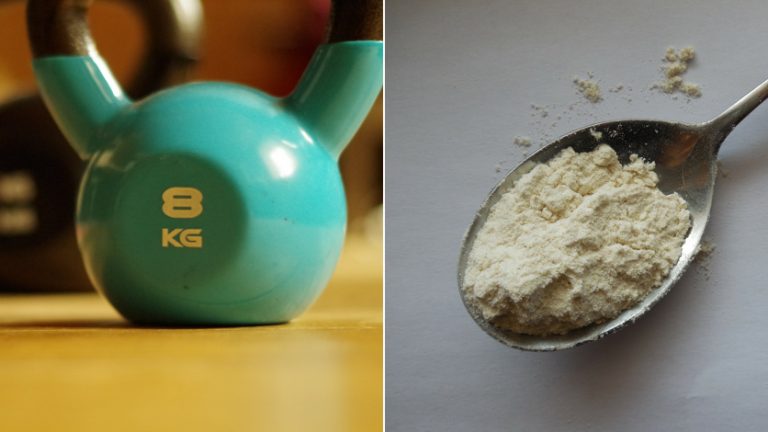
Protein
One of the things that rings alarm bells for me is when people are using protein shakes or powders along with doing 5:2
One of the key messages from the researchers in the field of Intermittent Fasting and Calorie Restriction, such as Prof Valter Longo and Luigi Fontana, and supported by Dr Michael Mosley, is
that we should be limiting our intake of protein1, and getting as much of that protein as we can from plant based sources2.
Their maximum recommended intake of protein is 0.8g per kilo of body weight.
Protein, and in particular animal protein, raises our levels of IGF-1, which is a growth promoter that can lead to accelerated ageing and cancer. We need high levels of IGF-1 whilst young, but not when we are mature. Fasting helps us to reduce the amount of IGF-1 thereby reducing our risk of cell proliferation and the degenerative effects of ageing and potentially increasing our lifespan.
But what if you are weight training or exercising hard?
There is an awful lot of promotion of protein powders and supplements within the fitness and ‘health food’ industries. A lot of marketing hype and selective highlighting of questionable research.
Those who have been on the inside of the industry are starting to point out that really it is absolutely not necessary to follow a training session with an intake of protein. Provided you eat a reasonable meal within an hour or two, either before or after your training, your body can adequately repair and build muscle3.
It has been shown that even those on a specifically low-protein diet, because of kidney problems, can grow muscle[4]. It is the training that helps you to build muscle, not the protein. As long as you eat a well-balanced diet, then your body can provide the energy needed by your cells.
Excess protein is not better for you than having sufficient and may actually cause harm.5 6 7
Most protein powders are made from whey, an animal product and actually a by-product of food manufacturing. The food industry just loves to package up its waste and find a way to market it to you.
Protein Powder may contain all kinds of additives8 and as they are not controlled as a food would be, there is no regulation over their contents or sources. Sweeteners, gum, salts, flavourings, heavy metals…. These things really don’t go well with the idea of lifestyle that is intended to improve your health, especially when we are looking to reduce our intake of refined and processed foods.
Yes we need adequate protein, but there is no advantage to having more than is necessary. Eat a nice tofu burger. Eat nuts, seeds, legumes and leafy green vegetables. Make the most of quinoa and whole grains. Enjoy a steak or any other meat occasionally. Have a couple of eggs. Add some yogurt to get the benefit of some probiotics. Eat oily fish and get your Omega 3 fats at the same time.
Don’t listen to me, read what body builders have to say…
Brad Pilon (Eat Stop Eat) – How Much Protein Do We Really Need to Eat?
Robert Cheeke (Vegan Bodybuilding and Fitness) – No Whey Man, I’ll Pass on the Protein Powder
Or read the nutritionists, personal trainers and health coaches:
Eirek Garnas – Why You Don’t Really Need a Post-Workout Protein Shake
Julie Peláez – Why You Really Shouldn’t Use Protein Powders
Tony Schober – 6 reasons to stop using Protein Powder
Lauren Macdonald – 10 reasons to avoid Protein Powder and Supplements
Christopher Wanjek (Bad Medicine, Food at Work) – Protein Supplement Myth
Billie’s 5:2 diet success story

Billie’s Story
I have struggled with this weight for years finally weighing 15 stone at my heaviest. Like many people I have been on every diet known to man and have successfully managed to lose weight on all of them but never managed to maintain the loss due to the fact that I just could not live that way long term.
I have messed with my metabolic rate so much over the years with the yo yo dieting that I now find I gain weight on a very low calorie intake of 1000 cals.
I decided in August last year after yet another weight gain (having lost 5 stone just calorie counting and putting two stone back on after breaking my leg) that something had to change. I heard about the 5:2 regime and watched the documentary. I was inspired to try this more for the health benefits than for anything else really and started straight away with back to back fasting.
My weight had gone up to 184 pounds and I had an added incentive to lose this as my son is getting married in Barbados in May this year so I was totally focused in making this work. This time however, I made the conscious decision that this was not going to be just another diet – a means to an end of losing weight for a particular event, but this was going to be a change to my way of life!
I have been b2b fasting ever since and finding it really easy actually. The hardest thing was finding different things to eat on the fasting days. I am still struggling with increasing my calories but this is my next mission! Having reached my goal of 10 stone last week 7 months since starting, my plan is to try now to lose another 7 pounds so that I don’t have to worry about it on my holiday but when I get home, I am going to tackle the issue of my low calorie intake. I need to increase my calories to at least 1200 a day and more if possible and I am determined to do it.
The health benefits have been amazing so far too – I no longer suffer from heartburn, my joints have improved immensely, I have not suffered from flu or a cold this winter and I feel amazing!
My husband has also started doing the 5:2 which is a big plus for me as we can fast together – he has lost 21 pounds so far and is doing really well.
I hope this helps anyone thinking about trying this way of life, I can really recommend it whole heartedly.
Billie Stevens (Age 64)
Weight Loss since August 2014: 44 pounds
Cheryl H’s 5:2 diet success story
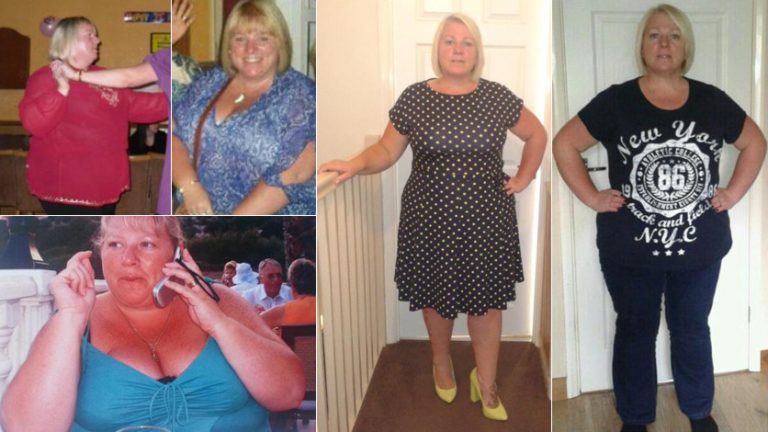
My journey so far
“I was a snug Size 26 now size 18 – 6st 10lb loss so far!”
February 2013 after hearing/discussing the Horizon programme with work mates we purchased the book, read it through a couple times and decided to give it a go. Three of us started, 2 weeks in one gave in, 4 weeks in the other one stopped and 22 months later I’m still 5:2ing and it’s just a way of life now not a chore at all.
Shortly after starting I had a routine docs appointment and was put on blood pressure tablets, I was not happy and vowed I would stick with this to make myself fitter and healthier.
The first year flew by and to be honest not many people noticed my weight loss until I had lost about 4 stone and yes the clothes were far to big but I was use to wearing big to cover me up. The second year the loss has slowed down but it’s still going down which is fine by me…slowly but surely.
I do exercise, my husband bought me a cross trainer and a vibration plate (not just for me we all use them) which are used Monday to Friday and when the whether is better I swim on my fasting days. I’m so much more confident, before I started losing weight I would never have gone swimming.
I’m not a ‘preacher’ but when asked what diet I’m doing I will say it’s not a diet I follow 5:2 and explain a little but always say to read the book and decide for yourself – and to go on the forum, it’s brill!!!
I set myself a goal to get back on my husband motorcycle, the last time I road pillion was 27 years ago and in August 2014 I went shopping, bought myself a bike helmet, jacket, boots and gloves. He got a new motorcycle and off we went.
My next goal is to be brave enough to go to the gym with hubby or daughter and being able to maintain when I am at a weight I am comfortable with not what doctors say I should be.
Finally thank you to the FastDay Forum users for all inspiration, information and help which keeps me on track.
5 fun and creative ways to track your weight loss
Many fasters use various weight tracking apps or indeed FastDay’s own Progress Tracker – but that’s not what I’m talking about today. While some of us find charts and graphs a thing of beauty, we don’t necessary want to pin them up around the house to admire! It is however nice to have a reminder of how far we’ve come and there are loads of creative and fun ways to do this.
Sure, you can buy little “lbs lost” chalk boards to hang up and write your losses and goals in pretty pastel colours – but what about the ideas below which you can do with things you may well have lying around the house, or can pick up for relatively little cost?
#1 Two containers, and lots of pretty little things
This is one of the simplest and most inexpensive ways you can represent your weight loss visually at home. You can even make it match your décor! All you need is a couple of jars, glasses, vases or similar and enough pretty little items to represent the lbs you want to lose! You could use buttons, pebbles, gemstones or marbles (anything you like really!) depending on the size of your containers and how many lbs you want to lose. Label one contained for ‘lbs to lose’ and one for ‘lbs lost’, moving an item from one jar to the other as you lose weight. Thanks go to Dawn Rose for the picture of her weight loss marble bowls.
#2 Building block towers
I saw this from a user on a 5:2 Diet Facebook group and she kindly allowed me to use the above image (thank you Sarah Deller!). If you’ve got kids, the chances are you have some kind of building blocks you could use as shown above to display your current weight and how far you’ve come.
#3 Pretty magnets on a noticeboard
I love this DIY weight loss progress chart project I found on this website, so if you’re feeling crafty this could be just the project for you to keep you busy on a fast day. If you’re less crafty, you could just put a headed-up sheet of paper on your fridge door with a column for lbs lost and lbs to lose, using magnets to hold it up. Being on the fridge serves the added purpose of reminding you how well you’ve done each time you head for the cool cupboard of delights.
#4 Pegs on a ribbon
This simple crafty idea I spotted on Pinterest is inexpensive and really cute! A few pieces of ribbon or string, some mini crafting pegs and some coloured card are all it takes to put this weight tracker together. I may have to make one of these for my kitchen!
#5 Charm jewellery
Those ever popular charm bracelets and necklaces can be bought quite cheaply if you’re not fussed about sterling silver or branded beads. Why not treat yourself to one and buy a new bead or charm each time you lose a certain amount of weight? It not only marks how much you’ve lost, but also is a nice way to reward yourself for your continued success. If you’re creative you could even make your own bracelet – be sure to make it adjustable though as you may find when you’ve lost all the weight it’s too loose! 😉
Need more ideas?
-
If you’ve got 24lbs or less to use, why not use a numbered advent candle and burn a little each time you lose 1lb?
- Reward yourself by putting a coin in your piggy bank for each 1lb lost – when you reach goal, you can get yourself a nice (non-food!) treat to congratulate yourself.
- How about starting your own pretty artificial flower bouquet to display in your home? Get yourself a lovely new floral piece to add to it for every 1lb you lose. As you get smaller, the bouquet gets bigger!
Do you track your weight loss in a creative way? We’d love to hear how you do it! Let us know in the comments!
You’ll never see cauliflower the same way again…
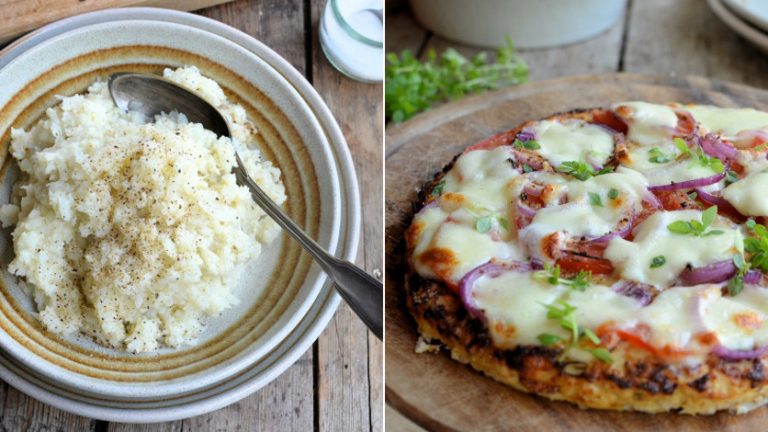
If you’ve read our article about smart food swaps to save calories you’ll already know at least one new way of enjoying the humble cauliflower as a filling, tasty and healthy side dish, but I’m sure at least a few of the below ideas will be new to you. By the time you finish reading, you’ll be itching to buy yourself a cauliflower and try out these amazingly inventive cauliflower recipes – especially when you see how low calorie they are! Better yet, cauliflower is low in carbohydrates so won’t make you feel more hungry after you eat it.
#1 Cauliflower Mash
Ah mashed potato – a great British staple and side dish to many a warming winter meal. You can save yourself a whole heap of calories as well as carbs by swapping the mash for cauliflower mash, at only 35 calories a serving using this great recipe from Lavender & Lovage. If you’re not a big fan of that cauliflower taste, you can adjust the recipe to include garlic, herbs or anything you would usually add to your mashed potato. Or why not go half and half, mixing cauliflower mash with mashed potato to cut back on the calories just a little?
#2 Cauliflower Crust Pizza
Look at that delicious pizza up there… would you believe the crust is actually made using cauliflower? The whole pizza comes in at under 500 calories thanks to yet another great Lavender and Lovage recipe. Don’t expect it to taste like a normal pizza base, but do expect a filling and healthier meal full of all the great flavours of pizza thanks to there being enough calories to top it with all the usual suspects! I’d cut back on the cheese a bit and throw on some extra toppings or serve with a side salad.
#3 Cauliflower Tortillas / Tacos
This is one I really must try out as we have Mexican food most Saturdays in my home and I’ve always preferred a soft shell for my tacos than those crispy ones which break and make such a terrible mess! These low calorie cauliflower tortilla wraps don’t have to just be used for Mexican food, fill them with whatever you like, turn them into little pizzas, the possibilities are endless (well, maybe not endless but you can do as much with these as you can with a normal soft tortilla!). Here’s a recipe from Slim Palate for oven baked cauliflower tortillas and one for a quicker pan-cooked version from The Healthy Foodie.
#4 Cauliflower Breadsticks
Starting to notice a bit of a theme now eh? Cauliflower can replace many of our favourite grain laden, carby bread products! This recipe from An Edible Mosaic offers a delicious sounding cauliflower based alternative to garlic bread – perhaps a nice accompaniment to courgetti ‘pasta’?
#5 Cauliflower Hummus
If the idea of dunking sticks of low calorie vegetables into nice healthy beans (in the form of hummus) appeals to you, perhaps the idea of dunking your vegetables into another vegetable is even more appealing! This recipe for cauliflower hummus from Oh My Veggies contains around 25% fewer calories than chickpea hummus per serving.
#6 Creamy Cauliflower Sauce
This one looks simply amazing – a simple idea, and so low in calories at just 49 per serving. This cauliflower sauce recipe from Pinch of Yum looks super versatile not only in terms of tweaking the ingredients to change the sauce but also the sheer number of dishes you could use it with – rice, pasta, meat, vegetable – you name it! Heck, you could even make it cheesy and serve over more cauliflower for cauliflower cheese (double cauliflower cheese?).
#7 Cauliflower Rice / Cous Cous
Of course no article about the wonders we can make with cauliflower would be complete without this now legendary 5:2 classic, cauliflower rice. So simple to make and so very versatile – turn it into a dish in its own right by making it ‘special fried rice’ style, or use as a side in dishes which call for rice or cous cous. It has just 20% of the calories compared to boiled rice (25 calories per 100g vs 130 calories per 100g boiled rice) and you can find a recipe here, courtesy of Tinned Tomatoes.
Who would ever have thought you could do so many things with a cauliflower?!
Have you tried any of these recipes? What did you think of them? Have you tweaked them or invented new ones? Let us know in the comments!
10 tips for festive fasting
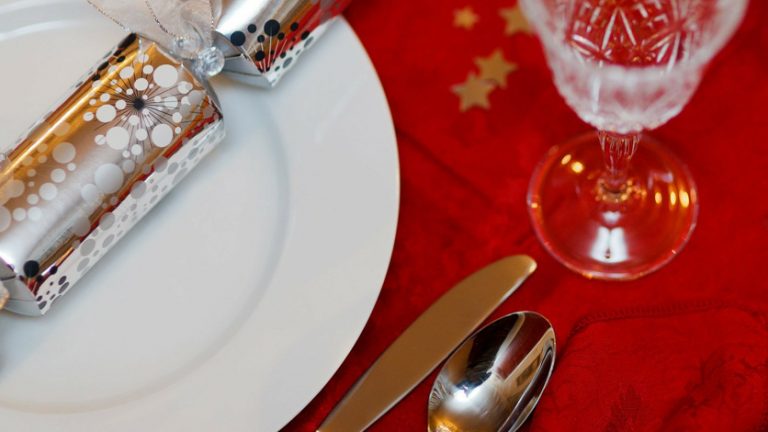
It’s the season to “eat, drink and be merry” as many call it, but if you’ve been losing weight you probably don’t want to undo all that hard work. Did you know the average Briton gains around 6lb over the holiday season? And that’s just an average, which means that some will not gain so much, but others may gain even more! Don’t let the festivities set you back a month or two on your weight loss journey! I wrote these tips for my blog last year but thought it would be helpful to update them and include them here at FastDay. I’ve now had two festive seasons as a 5:2 faster, the first of which I came out half a pound lighter and last year I more or less maintained (if there was a minor gain it was very temporary indeed).
#1 It’s only a couple of weeks out of a lifetime!
Just as I tell people who are going on holiday or have special occasions coming up, 5:2 is a long-term change to your way of eating – it’s flexible fits around your life, not the other way around. So if there’s a week or two where fasting isn’t going to be possible or even if you feel like a bit of a break from it, it’s not the end of the world. You’ve got the experience and know-how to get back on track and do it again. You know that a short break doesn’t mean all is lost, it’s only a few fasts you’ll have missed out on, which is nothing really compared with a lifetime of intermittent fasting. So, don’t fret if you can’t fast! I saw a great quote on Facebook once although I forget where or who wrote it (sorry!) – “It’s not what you eat between December and January that matters, it’s what you eat between January and December”. So very true!
#2 Listen to your body – your eating habits have changed as have your tolerances and cravings
Those of you who have been fasting for a while or more will probably have noticed by now that your eating habits have changed. You may be inclined towards smaller portions or bulking meals out with lovely nutritious vegetables. You may well be craving less junk and learning that certain foods only lead down the path of making you want more of them – refined carbs for example, which peak your blood sugar and then cause a sudden drop, causing you to feel hungry again. You’ve possibly also found that you simply can’t manage large quantities of rich foods any more, that your body will complain to you if you have too much of this sort of thing and that the unpleasant after effects (‘rapid transit’ as we sometimes call it at the forum) and stomach pains are enough to remind you not to indulge like this again. Use these to your advantage, enjoy your festive treats but listen to your body and don’t go so far as to cause yourself physical discomfort. If you do it once, you’ll certainly remember why you ought not to do it again. I know that’s true for me! Another important thing to be aware of is that there are a lot of bugs going around at this time of year – I’m sure I’m not the only one who has spent a Christmas or New Year feeling rotten from a cold or flu. Be careful about deciding whether or not to fast if you’re not feeling on top form over the holidays. We’re doing this to improve our health after all.
Read about fasting when unwell
Read about how fasting changes our eating habits
#3 Modify your fasts to fit
If you can’t fit in a normal fast day due to social commitments over the holidays, you can try modified forms of fasting. There is of course the option of going with 16:8 fasting – a feeding window of 8 hours each day and a 16 hour fast (including sleep) between them – this basically amounts to skipping breakfast. Many 5:2ers use this for maintenance or have naturally slipped into it for their feed days due to lack of hunger in the mornings. Another option to consider is what I call a ‘half fast’ if you’re a faster who normally goes without any calories until dinner. Fast until dinner as you would usually but allow yourself a normal dinner, particularly if it’s a day where you’re expecting a big dinner/meal out etc. This can enable you to enjoy a good social meal without going overboard on your daily calorie intake. This method is also known as Fast-5, a shorter feeding window approach. Above all remember that you should not be allowing your fast days to feel like punishment or any more restrictive than your usual fast days. You don’t want to start begrudging them. On my fast days over the holidays I am more lenient about my calories – allowing more in the region of 700 calories or so – even having a chocolate or two within that limit if I really wanted to. Christmas only comes once a year after all!
Read about different methods of intermittent fasting
#4 Consider occasional meal substitution
Another thing I’ve done over Christmas to keep my calories down while still enjoying the festive food was to swap meals out for treats on occasion. This is something I do in life generally anyway – so if you fancy that slice of cake with a dollop of cream, have it but do so instead of your lunch rather than as well as it. Maybe add a piece of low calorie fruit or salad for some proper nutrition. Make sure you have a nice healthy dinner bulked out with vegetables to get the nutrients you need and balance out the less healthy things you ate. Obviously this sort of treat-for-meal food swapping is not a healthy way to eat each and every day, but now and then it serves as an option to keep your intake more balanced instead of being excessive.
#5 Bubble and squeak is easy and awesome
Bubble and Squeak, for those who haven’t heard of it, is a meal made from vegetable leftovers and therefore really quick to make as well as being full of goodness and super tasty too! I always cook extra on Christmas day because I honestly enjoy my bubble & squeak more. I eat it for several days after, with a bit of leftover turkey or lean ham – often with a nice runny poached or lightly fried egg on top. Delicious! Just mash up those leftover roasties (potatoes, parsnips, squashes, sweet potatoes etc work well – but you could make a cauliflower mash to keep the calories doqn), chop the vegetables and mix it all up in a bowl. Lightly oil a small frying pan and press the mixture into it, making a sort of thick vegetable pancake. Turn out onto a plate when heated through and let your runny poached egg break on the top of it. It’s filling, it’s quick, it’s full of goodness and I find it makes a great meal to balance out those days where I’ve eaten a few more Christmas sweets than I probably should have!
#6 Plan to be flexible
By all means go into the holidays with the best of intentions – know what your plan is if you intend to try to fast, decide which days and what you can eat (I like to prepare my meals ahead of time and freeze them in for ease, knowing I don’t have to cook from scratch particularly over the holidays makes it that much easier to stick with a fast), but don’t feel bad if the plans change. The last two years my plan was to fast on Christmas eve but allowing myself 600 calories in the form of fillet steak, home-made potato wedges, vegetables and a little cheese sauce. I did it the first year year (it was delish!) and it meant I didn’t feel capable of overloading my tummy the next day but I could still enjoy a healthy sized meal – without the bloated, stuffed feeling which gives me no pleasure. Last year we ended up with guests on Christmas eve and I wound up having a little extra in the evening, but I still had the benefit of my usual 24 hour fast and less calories than I would otherwise have had that day. As I said earlier, it comes but once a year and change of plans or missing a fast is not the end of the world. Being organised and having good intentions can help you keep on track, but don’t feel bad about it if you have to change your plans – or even if you choose to just because you want to. Just don’t make a habit of it!
Read about inventing your own fasting method
#7 Don’t aim to lose, aim to maintain…
It is said that over the festive period most people will gain close to half a stone (which means they’re probably eating about twice as much as their body needs!). Be realistic – don’t aim to lose over the festivities, you don’t want to feel deprived or like you’re some kind of martyr to your diet. 5:2 is about being able to enjoy your food still, remember? So, aim to maintain – or at least not to gain more than a pound or two, which you know you can shift again pretty quickly when your feet are firmly back on the 5:2 wagon in the new year. If you can fit in some fasts or half fasts you should be able to keep your calories relatively balanced and come out the other side of the holidays seeing the same sort of numbers on the scales as before. Don’t feel disappointed if it’s up a little, you know how to lose it and we’ve all had blips. Don’t be hard on yourself, we’re all our own worst critics when we should be our biggest supporters.
#8 Don’t beat yourself up if you gain a little
Following on from the above, we all know how annoying it can be to see the numbers go up on the scales. The important thing is to have a bit of perspective. Look at how far you’ve come and always remember how much you have already achieved. For what it’s worth let me tell you that this year – having had a serious medical condition – I have unfortunately regained a lot more weight than I would ever have wanted to. I remember how disappointed I felt after a holiday last year when I came home to find I had gained a few lbs… but having regained so much now, that little holiday gain has really been put into perspective. A few lbs is not worth getting horribly upset about, so pick yourself up and get back on track before the numbers creep up more and more. I console myself with knowing that I still weigh considerably less than I did a couple of years ago and that in terms of being considered successful, my loss is still significant (I have maintained a loss of more than 10% of my starting body weight… even if I did get as far as over 20%) and I’ll not allow myself to end up back at square one if I have anything to say about it! Remember also that if you’re partway through your weight loss journey and still have a fair amount of lose, a few lbs fluctuation on the scales is quite normal and isn’t necessarily indicative of an actual fat gain.
Read about how the scales don’t always tell the truth
#9 Eating all day every day feels weird and may make it less easy to get back into fasting!
Or at least, it does to me since I started 5:2. Hubs and I had a holiday last year and I didn’t fast at all. It felt strange, being used to having two days a week where I only eat dinner but finding myself eating meals throughout the day each day. When I got back from holiday my first fast felt just like my very first fast ever – headaches, grumpy, hungry – I’ll admit it was a struggle and took a fair few weeks to get back into the routine. How quickly the body forgets! I also remember the previous New Year it was difficult to get out of the habit of nibbling sweet treats during the day when I got back to work. I’m so glad I kept at my fasting last festive season so at least the fast days themselves weren’t difficult and I only had to get my feed days back under control. I must say I feel much better when I am fasting, I hated being unable to fast for much of this year while I was unwell, but since starting again I feel fantastic!
Read about the health benefits of fasting
#10 Keep in touch with your fasting friends
There’s nothing better for keeping you on the straight and narrow than checking in with your fasting friends. We’re all in this together! Be sure to pop in to the forum and also to log your weight on the progress tracker to help keep yourself in check.
This Christmas you probably already weigh less than you did last year, and next year no doubt less still – perhaps even maintaining a healthy weight. Whatever you do over the holidays, however you choose to fast – or not – it’s not the end of the world. Enjoy yourself, be mindful and remember there’s a new year coming and a healthier, happier you to strive for.
15 holiday gift ideas for fasters
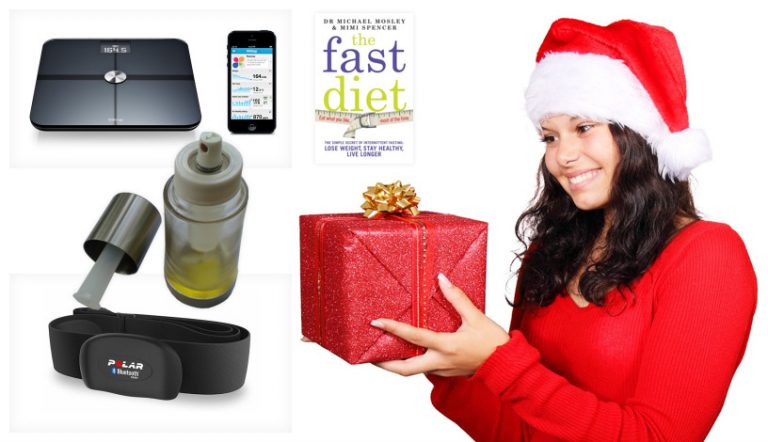
With less than a month to go until Christmas if you need a gift for a fasting friend or haven’t written your own Christmas list yet, I hope the ideas below are helpful. From health & fitness gadgets to kitchen helpers and stocking fillers, there’s something to suit most budgets here. If you’ve got more ideas, we’d love to read about them in the comments!
#1 Heated USB Computer Mouse
If you’ve fasted, you’ve probably noticed that you feel the cold a bit more on your fast days. I notice it especially in my hands and working a desk job I found my fingers were always freezing on a fast day. I no longer need to look like an oddball wearing gloves while I type, as my husband bought me one of these fantastic heated mice last Christmas. With two heat settings (as well as being able to turn it off for the warmer months) I love this mouse and I’m sure many other fasters would agree! You can also get heated mouse mats, some of which are pretty cute (but maybe not so suitable for a workplace!).
Heated USB Mouse & Mouse mats on Amazon UK | Heated USB Mouse & Mouse mats on Amazon USA
#2 Spiral Vegetable Slicer
If you do a bit of low carbing on your fast days, you may have already tried ‘courgetti’, making spaghetti style noodles from courgette (zucchini) – or other vegetable ‘noodles’. This kitchen gadget makes the job of turning your vegetables into low calorie, low carb noodles fun, quick and easy.
Spiral Vegetable Slicers on Amazon UK | Spiral Vegetable Slicers on Amazon USA
#3 Oil Sprayer
Many fasters rely on low calorie oil spray products to keep their calories down on a fast day – but did you know many of these sprays contain added chemicals and are not pure oil? I’m a firm believer in minimising on additives where possible and was delighted to receive a pump action oil sprayer last Christmas. You can fill these with whichever kind of oil you prefer – no added chemicals and much kinder to the environment as you won’t be having to throw away empty spray cans all the time.
Oil Sprayers on Amazon UK | Oil Sprayers on Amazon USA
#4 Hot Drinks Maker
Whether you prefer tea or coffee on your fast days you can enjoy a range of quick and fuss free, calorie counted beverages using these pod and capsule based hot drinks makers. I’ve even seen some low calorie hot chocolate pods available. Maybe Santa will bring me one this year!
Hot Drinks Makers on Amazon UK | Hot Drinks Makers on Amazon USA
#5 Smart Kitchen Scales
If you’re tired of having to count calories the old fashioned way, why not put a set of smart kitchen scales on your wish list? These modern miracles connect wirelessly to an app on your smart phone or tablet, allowing you to find out not only the calorie count for your meal as you weigh out the ingredients but also the full nutritional information. These are at the top of my list for this year, in the form of the SITU Scales due out soon in the UK. Escali offer a similar product in the USA.
Smart Kitchen Scale from SITU in the UK | Escali Smart Kitchen Scales on Amazon USA
#6 Smart Body Analyser Scales
Another way to simplify weigh ins and tracking your weight loss, Smart Body Analyser Scales transmit your weigh in data directly to an app on your phone or tablet to keep track of your progress and chart it for you. Some of these scales are pretty clever, measuring not only your weight, body fat and water content but also able to check your heart rate, air quality, temperature and forecast the weather for the day, such as the Withings WS50 smart scales, which I can highly recommend as a satisfied user!
Smart Bathroom Scales on Amazon UK | Smart Bathroom Scales on Amazon USA
#7 Activity Trackers
Many fasters find themselves wanting to increase their fitness level as they lose weight and what better way to track your activity levels and improvement than with a fitness tracking device such as the Fitbit or Withings Pulse O2. I must have been a really good girl last year as I found one of these under my Christmas tree as well! I wear it on a daily basis to track my movement, heart rate (this may have saved my life, but that’s another story!) and calories burned, I also wear it all night to monitor my sleeping patterns. A great gift for anyone who wants to get a better picture of their health overall, especially in combination with some smart bathroom scales.
Activity Trackers on Amazon UK | Activity Trackers on Amazon USA
#8 Fasting Reference & Recipe Books
If you’re buying for a relatively new faster, a fasting book would make a great and inexpensive gift – whether it’s the original The Fast Diet book by Dr Michael Mosley and Mimi Spencer, or one of the many other 5:2 diet books these make a great starting point for new fasters. There are loads of great recipe books out there too and as most cooks will tell you, you can never have too many of these!
5:2 Diet & Fast Diet Books on Amazon UK | 5:2 Diet & Fast Diet Books on Amazon USA
#9 Clothes Shop Vouchers
Most of us long term fasters will know why this is – once we get fed up of our trousers falling down and jumpers engulfing us, it’s time to invest in some new additions to the wardrobe. If you don’t know what to get your fasting friend, I’m sure vouchers for their favourite clothes shop would be gratefully received.
…and don’t forget those Christmas stocking fillers!
#10 Low Calorie Hot Chocolate
Many of us swear by these as a treat on a fast day (especially to help us get to sleep!), so a pot (or some sachets) of this make for a good stocking filler for a faster. Highlights and Options are the usual brands we see mentioned at the forum and on Facebook, but Galaxy also have a low calorie offering and I must say I’ve recently been enjoying the Sainsburys own brand alternative, which has fewer calories (36) and makes a really nice thick drink with a less sweetened flavour. If you’re a bit creative you might even like to try making this recipe for a low calorie hot chocolate (let us know how you get on, I’ve yet to try it!) and wrapping it up festively.
Low Calorie Hot Chocolate on Amazon UK | Low Calorie Hot Chocolate on Amazon USA
#11 Pocket Hand-warmers
For those fasters who don’t work at a desk (so can’t use a heated mouse) but get chilly on their fast days, pocket hand-warmers are an ideal sized gift for in a Christmas stocking as well as being practical.
Pocket Hand-warmers on Amazon UK | Pocket Hand-warmers on Amazon USA
#12 Pocket Book of Calories
Handbag-sized and really helpful, these mini calorie guides have been really helpful to me and my friends when cutting down on the calories and are also a nice sized gift for in a stocking.
Pocket Calorie Books on Amazon UK | Pocket Calorie Books on Amazon USA
#13 Tape Measure
When I was little, stocking fillers were not expensive gifts. They were little things, for fun or for practicality – or often just little edible treats. Stocking fillers needn’t be expensive and this idea is certainly not going to break the bank. A simple tailors tape measure is useful for keeping track of our measurements as we lose weight and is dirt cheap. That’s the best kind of stocking filler if you ask me! Of course you could push the boat out and buy a pretty retractable one (every woman should keep one in her handbag!), which does make for a nicer gift but isn’t quite so inexpensive.
Retractable Tape Measures on Amazon UK | Retractable Tape Measures on Amazon USA
#14 Simple Pedometer
If your budget doesn’t stretch to a fancy activity tracker, or you simply don’t need all those extra bells and whistles, a simple pedometer is a nice way to measure your activity levels and encourage you to increase them. My first one came free with a box of cereal, but really motivated me to move around more each day. These needn’t be at all expensive and make an ideal stocking filler for a faster who also wants to improve their overall health and fitness.
Pedometers on Amazon UK | Pedometers on Amazon USA
#15 Stock Cubes
Yes, you read that right, I said stock cubes – as a stocking filler! As mentioned previously, I like my stocking fillers to fall into one of these categories – fun, practical or edible. These fall into all three categories – any faster is bound to chuckle when they unwrap a pack of these! Loads of us enjoy a stock cube drink on a fast day to help stave off the headaches and as a sort of low calorie soup. So, they’re fun, they’re edible and a practical gift – on top of that, a box of these is stocking sized, inexpensive and available from your local grocery store. Brilliant!
What’s on your Christmas list this year? We’d love to hear your suggestions!
4 easy ways to count the calories in your meals
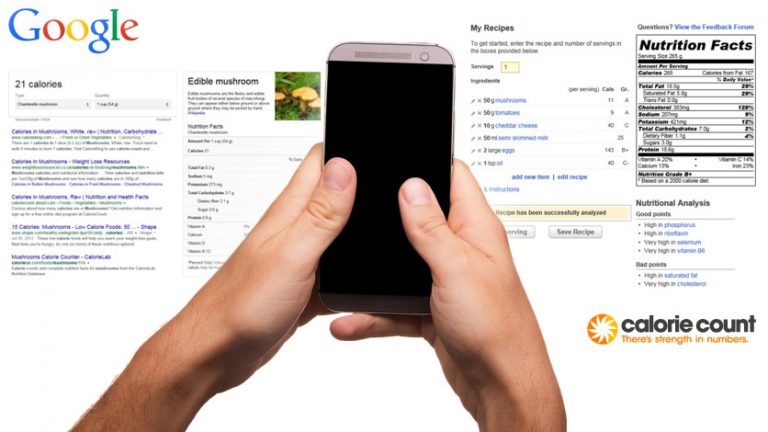
These days most pre-packaged foods come with nutritional information printed on the packaging for your convenience – even if sometimes it can be a bit difficult to understand and lead to fasters making the mistake of miscounting their calories!
But what can you do if you’re using fresh ingredients to cook from scratch? How can you easily work out how many calories are in your fasting meal? Here are our top tips on how to count the calories in your meals. The only thing you need is a good set of kitchen scales and one of the following…
#1 Google Nutrition Information
Is there nothing Google can’t do?! Many of use Google to look up all sorts of information, from product prices to shop opening times and travel directions, but did you know that Google can also give you nutritional data for just about any ingredient you can imagine? Just type something like “calories in mushrooms” and Google will present you not only with a quick way of checking the calories for different quantities of different kinds of mushrooms, but also full nutritional information on the right hand side of the page. Brilliant!
#2 The Calorie Count Recipe Analysis Tool
It always surprises me that more people don’t know about this tool – it’s so handy and best of all, it’s free! Simply enter the recipe ingredients into the box on the recipe analysis page, something like this:
50g mushrooms
50g tomatoes
10g cheddar cheese
50ml semi skimmed milk
2 large eggs
1tsp oil
Don’t forget to enter the number of servings made from the recipe into the box at the top, if it’s more than one serving. Now click the Analyze Recipe button and voila! an instant calorie calculation for your recipe, including a full nutritional breakdown and a list of the good and bad points about the recipe, nutritionally speaking. The above simple omelette contains 268 calories according to the tool, why not try it for yourself?
#3 Calorie Counting Apps
Need to count calories on the go? Try a calorie counting app! There are lots of good calorie counting apps available for free on both Android and iOS platforms.
#4 Smart Kitchen Scales
Here’s one for the gadget lovers out there! Relatively new to the market, smart kitchen scales connect wirelessly to an app on your mobile device, allowing you to check the nutritional information of ingredients and foods as you weigh them. I haven’t yet found any that are readily available in the UK (although a company named SITU is apparently working on some smart kitchen scales for the UK & European market), but if you’re based in the USA, check these Escali SmartConnect Kitchen Scales out – not only do they give you the nutritional info but they’ll also allow you to keep a food diary through the associated app.
…but that’s not all! Here’s a bonus method, waiting for the technology to be ready at some point in the (hopefully near) future.
BONUS #5! Microwave Calorie Counting Device
I’m sure I’m not the only one who can’t wait for this to be available! No doubt one day down the line our cookers and microwave ovens will have this feature built in, but the prototype shown on this article from The Telegraph does look really quite cool!
Do you know of any other quick & easy ways to tot up the calories in your fast day meals? Let us know in the comments!
Corey’s 5:2 diet transformation
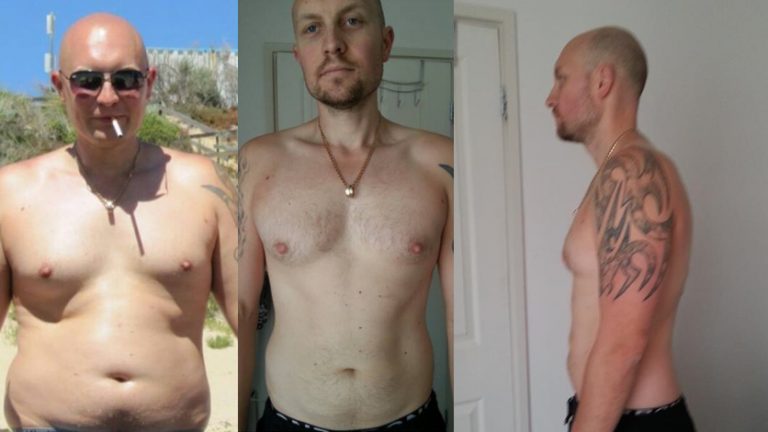
Corey’s story
I started my health journey 6 months ago. After spending most of my adult life fluctuating between overweight and obese, I decided my lifestyle needed to change. I began looking into vitamins and minerals. Along the way a good friend mentioned fasting but I originally rejected the idea as “crazy”. Then about 4 months ago I watched Dr. Michael Mosley’s documentary Eat, Fast and Live Longer.
This is when I began my fasting journey. My goal wasn’t weight lose but general health. I was interested in lowering my IGF-1 and reducing my risk of diabetes and high blood pressure (both run in the family). My first fast was the hardest, I even packed my food as a normal day because of the fear of not eating, but since then it has gotten easier with each one. I fast on Mondays and Thursdays, unless there’s a special occasion, then I’ll swap my days.
I’ve been fasting for 4 months now and have managed to drop from 108kg to 92kg and also maintain it. I love the life style as it doesn’t restrict me on the weekends and I can change my fast days to suit my week. I only drink water until dinner and usually just have a regular dinner with the family. I don’t usually count my calories as a regular sized home cooked meal would be around the 600 calorie mark. (I sometimes alter the meal slightly, e.g. Brown rice with my bolognese instead of pasta).
My biggest goal each fast day is to maximize my breaks between food, so my body gets the time it needs to repair itself. I look forward to continuing this way of eating for the rest of my life… It’s by far the best change I’ve made to my diet.

